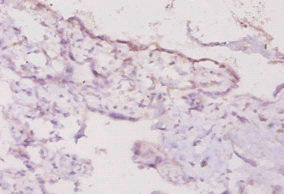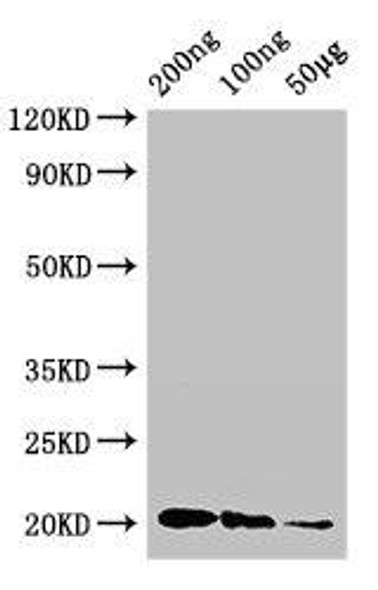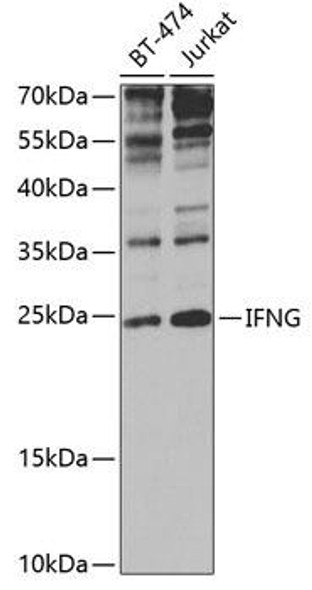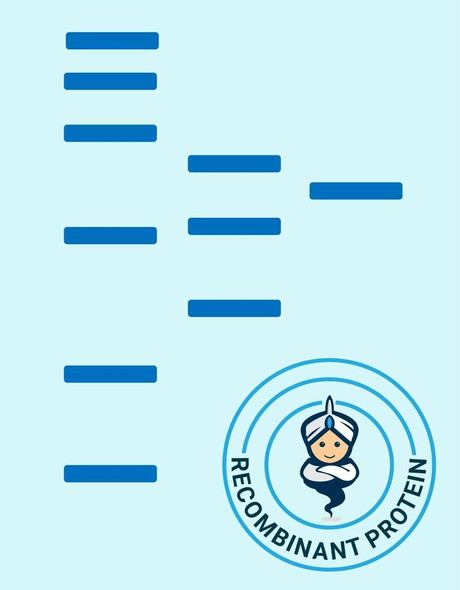Description
Ifng Antibody (PACO33624)
The IFNγ Monoclonal Antibody (PAC0336-24) is a valuable tool for researchers studying the interferon gamma (IFNγ) protein, a key cytokine involved in immune responses. This antibody is mouse-derived and highly specific for IFNγ in human samples, making it ideal for experiments such as ELISA and flow cytometry.IFNγ is known for its pro-inflammatory and immunomodulatory functions, playing a crucial role in the immune response to infections and cancer. The ability of this antibody to specifically target IFNγ allows for precise detection and analysis of its expression in various cell types, providing valuable insights into its role in immunity and disease.
Researchers studying autoimmune disorders, infectious diseases, and cancer will benefit from using the IFNγ Monoclonal Antibody to further understand the mechanisms underlying these conditions. By targeting IFNγ, this antibody opens up opportunities for developing targeted therapies that modulate immune responses and improve patient outcomes.
| Antibody Name: | Ifng Antibody (PACO33624) |
| Antibody SKU: | PACO33624 |
| Size: | 50ug |
| Host Species: | Rabbit |
| Tested Applications: | ELISA, IHC |
| Recommended Dilutions: | ELISA:1:2000-1:10000, IHC:1:10-1:100 |
| Species Reactivity: | Mouse |
| Immunogen: | Recombinant Mouse Interferon γ protein (27-155AA) |
| Form: | Liquid |
| Storage Buffer: | Preservative: 0.03% Proclin 300 Constituents: 50% Glycerol, 0.01M PBS, PH 7.4 |
| Purification Method: | >95%, Protein G purified |
| Clonality: | Polyclonal |
| Isotype: | IgG |
| Conjugate: | Non-conjugated |
 | Immunohistochemistry of paraffin-embedded human placenta tissue using PACO33624 at dilution of 1:20. |
| Background: | Produced by lymphocytes activated by specific antigens or mitogens. IFN-gamma, in addition to having antiviral activity, has important immunoregulatory functions. It is a potent activator of macrophages, it has antiproliferative effects on transformed cells and it can potentiate the antiviral and antitumor effects of the type I interferons. |
| Synonyms: | Interferon γ (IFN-gamma), Ifng |
| UniProt Protein Function: | IFNG: Produced by lymphocytes activated by specific antigens or mitogens. IFN-gamma, in addition to having antiviral activity, has important immunoregulatory functions. It is a potent activator of macrophages, it has antiproliferative effects on transformed cells and it can potentiate the antiviral and antitumor effects of the type I interferons. Homodimer. Released primarily from activated T lymphocytes. Belongs to the type II (or gamma) interferon family. |
| UniProt Protein Details: | Protein type:Membrane protein, integral; Cytokine; Secreted, signal peptide; Secreted Cellular Component: external side of plasma membrane; extracellular region; extracellular space; intracellular Molecular Function:cytokine activity; interferon-gamma receptor binding; protein binding Biological Process: adaptive immune response; antigen processing and presentation; apoptosis; CD8-positive, alpha-beta T cell differentiation during immune response; cell cycle arrest; defense response to bacterium; defense response to protozoan; defense response to virus; humoral immune response; immune response; inflammatory cell apoptosis; negative regulation of cell proliferation; negative regulation of epithelial cell differentiation; negative regulation of interleukin-17 production; negative regulation of myelination; negative regulation of smooth muscle cell proliferation; negative regulation of transcription from RNA polymerase II promoter; neutrophil apoptosis; neutrophil chemotaxis; positive regulation of autophagy; positive regulation of CD4-positive, CD25-positive, alpha-beta regulatory T cell differentiation during immune response; positive regulation of cell adhesion; positive regulation of cell proliferation; positive regulation of chemokine biosynthetic process; positive regulation of interleukin-1 beta secretion; positive regulation of interleukin-12 biosynthetic process; positive regulation of interleukin-12 production; positive regulation of interleukin-23 production; positive regulation of interleukin-6 biosynthetic process; positive regulation of isotype switching to IgG isotypes; positive regulation of killing of cells of another organism; positive regulation of membrane protein ectodomain proteolysis; positive regulation of MHC class II biosynthetic process; positive regulation of neuron differentiation; positive regulation of nitric oxide biosynthetic process; positive regulation of osteoclast differentiation; positive regulation of peptidyl-serine phosphorylation of STAT protein; positive regulation of synaptic transmission, cholinergic; positive regulation of T cell proliferation; positive regulation of transcription from RNA polymerase II promoter; positive regulation of transcription, DNA-dependent; positive regulation of tumor necrosis factor production; positive regulation of tyrosine phosphorylation of Stat1 protein; protein import into nucleus, translocation; regulation of growth; regulation of immune response; regulation of insulin secretion; regulation of the force of heart contraction; regulation of transcription, DNA-dependent; response to virus; sensory perception of mechanical stimulus; T cell receptor signaling pathway; unfolded protein response |
| NCBI Summary: | This gene encodes a soluble cytokine that is a member of the type II interferon class. The encoded protein is secreted by cells of both the innate and adaptive immune systems. The active protein is a homodimer that binds to the interferon gamma receptor which triggers a cellular response to viral and microbial infections. Mice deficient in this gene have increased susceptibility to viral, bacterial and parasitic infections and to several autoimmune diseases. [provided by RefSeq, Dec 2015] |
| UniProt Code: | P01580 |
| NCBI GenInfo Identifier: | 124480 |
| NCBI Gene ID: | 15978 |
| NCBI Accession: | P01580.1 |
| UniProt Secondary Accession: | P01580,Q542B8, |
| UniProt Related Accession: | P01580 |
| Molecular Weight: | 17,907 Da |
| NCBI Full Name: | Interferon gamma |
| NCBI Synonym Full Names: | interferon gamma |
| NCBI Official Symbol: | Ifng |
| NCBI Official Synonym Symbols: | Ifg; IFN-g |
| NCBI Protein Information: | interferon gamma |
| UniProt Protein Name: | Interferon gamma |
| Protein Family: | Interferon |
| UniProt Gene Name: | Ifng |
| UniProt Entry Name: | IFNG_MOUSE |
| Secondary Antibody |
| Anti-HRP Goat Anti-Rabbit IgG (H+L) Antibody (CABS014) |
| Recommended Products |
| Anti-FITC Goat Anti-Rabbit IgG (H+L) Antibody (CABS011) |
| Anti-HRP-conjugated Beta Actin Antibody (CABC028) |











